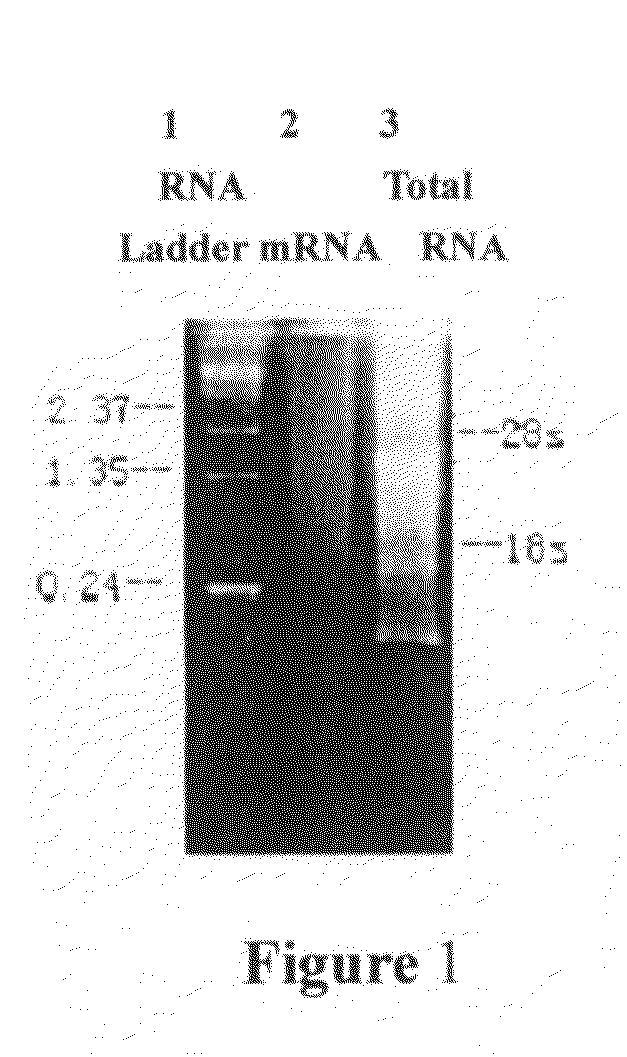Short chain neurotoxin from sea snake-Lapemis hardwickii and genes encoding the neurotoxin
a technology of lapemis hardwickii and short chain neurotoxins, which is applied in the field of short chain neurotoxins from lapemis hardwickii and their encoding genes, can solve the problems of high cost and low purity, sea snake venom, and high toxicity, and achieve the effect of increasing the pain threshold value of mous
- Summary
- Abstract
- Description
- Claims
- Application Information
AI Technical Summary
Benefits of technology
Problems solved by technology
Method used
Image
Examples
example
Example 1
The Construction of cDNA Library of the Toxin from Sea Snake—Lapemis hardwickii
[0043]Total RNA was extracted from the homogenous venom gland tissues of sea snake—Lapemis hardwickii by using one-step-extraction methods with hot phenol according to >[11]; mRNA was extracted later by using mRNA Purification Kit (Amersham Pharmacia); Then TimeSaver™ cDNA Synthesis Kit was used for the cDNA synthesis (Amersham Pharmacia), all protocol details were recommended by the manufacturer.
[0044]Total RNA of venom gland extracted by one-step with guanidine isothiocyanate was electrophoresed on 1% denaturing formaldehyde gel, three obvious rRNA bands—28S, 18S and 5.8S and several specific RNA bands were represented within smear RNA (as shown in FIG. 1), this indicated that total RNA was intact and the venom gland tissues were highly differentiation. mRNA extracted by using mRNA Purification Kit was electrophoresed as well, homogeneous smear was detected (as shown in FIG. 1), indicating the...
example 2
Sequencing and Analyzing of the Short Chain Neurotoxins of Sea Snake—Lapemis hardwickii
[0045]About 500 cDNA clones were randomly selected to isolate plasmid DNA by PEG purification[13]. DNA sequencing was performed using ABI 377 DNA Sequencer (available from BAO biological engineering Inc. DaLian) with universal T7 and Sp6 primers, each clone was sequenced positively and reversely to ensure the accuracy of gene sequence. The results showed that the abundance of the neurotoxin genes from cDNA expression library of sea snake—Lapemis hardwickii was very high. Among these neurotoxins sequenced, there are three different genes named sn12, sn36 and sn160 respectively encoding a protein of 81 amino acids, wherein a signal peptide of 21 amino acids and a mature peptide of 60 amino acids, all of them share the same typical primary structure of short chain neurotoxin, with the only variance of one amino acid, which locates at the 46th of the mature peptide, and it is Pro46, His46 and Arg46 r...
example 3
The Construction of Recombinant Sea Snake—Lapemis hardwickii Short Chain Neurotoxin Expression Plasmid
[0048]A pair of primers were designed according to the 3′ and 5′ sequence of the sn12, sn36 and sn160 genes that encoding the mature peptide, the forward primer (SEQ ID NO. 3) was:
[0049]
5′-CGG GGT ACC GAC GAC GAC GAT AAA Kpnl recognition site for enterokinase ATG ACA TGT TGC AAC CAA CAG TC-3′
the reverse primer (SEQ ID NO. 4) was:
[0050]
5′-CGC GGA TCC TTA ATT GTT GCA TTC GTT BamHITGT ATG GC-3′
PCR amplification and gene clone were performed using routine methods [13]. The details of expression plasmid construction procedure were shown in FIGS. 5 and 6.
[0051]The genes were then inserted into the prokaryotic fusion expression vector pETTRX which was previously constructed by our lab, then three expression plasmid pETTRXsn12, pETTRXsn36, pETTRXsn160 were obtained. The PCR products were approximately 220 bp (as shown in FIG. 7), encoding 60 amino acid residues. The target ...
PUM
| Property | Measurement | Unit |
|---|---|---|
| threshold | aaaaa | aaaaa |
| molecular weight | aaaaa | aaaaa |
| structure | aaaaa | aaaaa |
Abstract
Description
Claims
Application Information
 Login to View More
Login to View More - R&D
- Intellectual Property
- Life Sciences
- Materials
- Tech Scout
- Unparalleled Data Quality
- Higher Quality Content
- 60% Fewer Hallucinations
Browse by: Latest US Patents, China's latest patents, Technical Efficacy Thesaurus, Application Domain, Technology Topic, Popular Technical Reports.
© 2025 PatSnap. All rights reserved.Legal|Privacy policy|Modern Slavery Act Transparency Statement|Sitemap|About US| Contact US: help@patsnap.com



